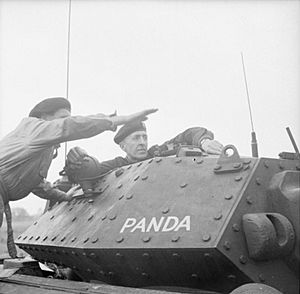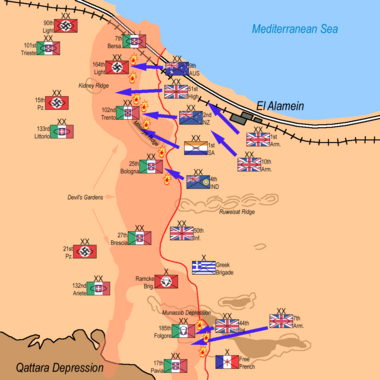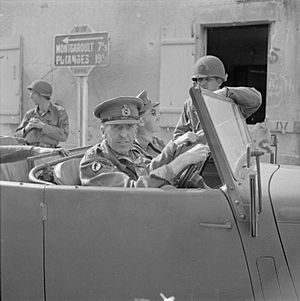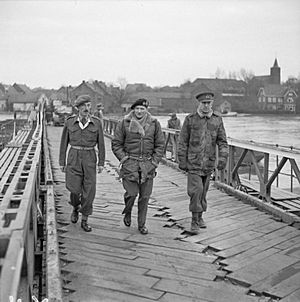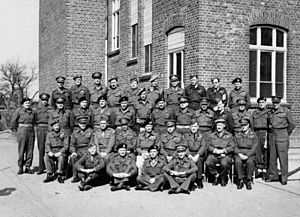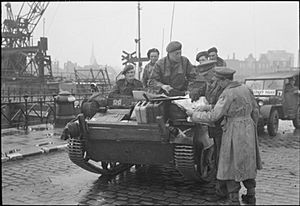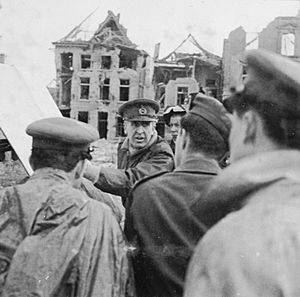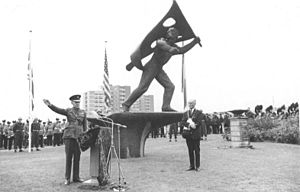Brian Horrocks facts for kids
Quick facts for kids
Sir Brian Horrocks
|
|
|---|---|
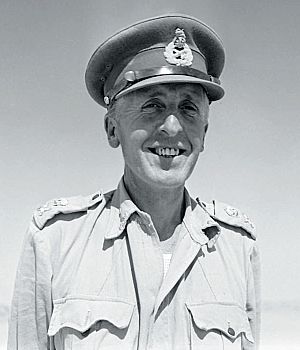
Lieutenant General Brian Horrocks commanding XIII Corps in North Africa, 1942
|
|
| Nickname(s) | "Jorrocks" |
| Born | 7 September 1895 Ranikhet, India |
| Died | 4 January 1985 (aged 89) Fishbourne, West Sussex, England |
| Allegiance | United Kingdom |
| Service/ |
British Army |
| Years of service | 1913–1949 |
| Rank | Lieutenant-general |
| Service number | 5821 |
| Unit | Middlesex Regiment |
| Commands held | British Army of the Rhine (1948) Western Command (1946–48) XXX Corps (1944–45) IX Corps (1943) X Corps (1942–43) XIII Corps (1942) 9th Armoured Division (1942) 44th (Home Counties) Infantry Division (1941–42) 9th Infantry Brigade (1940–41) 2nd Battalion, Middlesex Regiment (1940) |
| Battles/wars | First World War Russian Civil War Anglo Irish War Second World War |
| Awards | Knight Commander of the Order of the Bath Knight Commander of the Order of the British Empire Distinguished Service Order Military Cross Mentioned in Despatches (3) Commander of the Order of George I (Greece) Knight Grand Officer of the Order of Orange-Nassau (Netherlands) Grand Officer of the Order of the Crown with Palm (Belgium) Croix de Guerre (Belgium) Commandeur of the Legion of Honour (France) Croix de Guerre (France) Commander of the Legion of Merit (United States) |
| Other work | Black Rod Television presenter Author |
Lieutenant-General Sir Brian Gwynne Horrocks (7 September 1895 – 4 January 1985) was a British Army officer. He is best known for leading XXX Corps during Operation Market Garden and other battles in the Second World War. He also fought in the First World War and the Russian Civil War. He was captured twice and even competed in the modern pentathlon at the 1924 Paris Olympics. After his military career, he became a television presenter, wrote books about military history, and served in the House of Lords for 14 years.
In 1940, Horrocks commanded a battalion during the Battle of France. This was the first time he served under Bernard Montgomery, who became one of Britain's most famous commanders. Montgomery later saw Horrocks as one of his best officers. He gave Horrocks command of large groups of soldiers (called corps) in both North Africa and Europe.
In 1943, Horrocks was badly wounded. It took him over a year to recover. This long recovery likely stopped him from being promoted further. Other commanders he worked with went on to lead entire armies. His injury affected his health for the rest of his life. It led to him retiring early from the army after the war.
Many people since 1945 have seen Horrocks as one of the most successful British generals of the war. They described him as "a man who really led" and "a general who talked to everyone." General Dwight D. Eisenhower, who was the top Allied commander in Western Europe, called him "the outstanding British general under Montgomery."
Contents
Brian Horrocks: Early Life and Education
Brian Gwynne Horrocks was born in Ranikhet, British India, on 7 September 1895. His father, Colonel Sir William Horrocks, was a doctor in the army. His mother, Minna, was Irish and full of cheer. Brian had happy memories of living in Gibraltar as a child.
He returned to Britain for school. He went to Bow School, Durham and then Uppingham School. He always knew he wanted to join the army. He later said he spent most of his childhood playing sports and wasn't very good at studying hard.
In October 1912, he joined the Royal Military College, Sandhurst. He admitted he wasn't a great student there. He was "idle" and "scruffy." He was almost at the bottom of his class. He might not have become an officer if the First World War hadn't started in August 1914.
Fighting in the First World War
Horrocks became a second lieutenant in the Middlesex Regiment on 8 August 1914. He joined his battalion in France as part of the British Expeditionary Force (BEF). This was during the BEF's retreat after their first battle at Mons. He led 95 new soldiers, and three more even snuck in because they were so eager to fight.
He described the excitement of the time:
This was, I should think, the last time there was any romance attached to war. It is impossible now after the bitter experience of two world wars to recapture the spirit of this country in August, 1914. As I marched through those cheering crowds I felt like a king among men. It was all going to be over by Christmas and our one anxiety was whether we would get over there in time. And all ranks felt the same.
In France, Horrocks was part of the 1st Battalion of the Middlesex Regiment. He remembered "endless and exhausting marches." He found comfort in the humor of his soldiers. He also admired his company commander, Captain Edward Stephen Gibbons. Captain Gibbons made sure officers shared the same tough conditions as their soldiers. Horrocks later wrote, "My heart sank but I knew instinctively that he was right."
On 21 October, at the Battle of Armentières, Horrocks's group was surrounded. While defending the town of Maisnil, he was shot in the stomach and leg. He was taken prisoner. He later said, "The war for me was over and my active military career had stopped for four years."
He was held in a military hospital and questioned by the Germans. They thought the British were using illegal bullets. Conditions were tough at first, but improved when he moved to a prisoner of war camp. He became a lieutenant on 18 December 1914, even while captured. He tried to escape many times. Once, he got very close to the Dutch border before being caught again.
To stop his escapes, he was put in a camp with Russian officers. He used this time to learn Russian. Years later, he surprised Russian leaders Nikita Khrushchev and Nikolai Bulganin by speaking their language. He was held in Holzminden prisoner-of-war camp later in the war. For his bravery as a prisoner, he received the Military Cross (MC) in 1920.
When the war ended, Horrocks returned home. He found it hard to get used to peacetime. He spent four years of saved army pay in just six weeks in London.
Between the Wars: Russia and Home
Serving in Russia
In 1919, Horrocks was sent to Russia. This was during the Allied intervention in the Russian Civil War. He landed in Vladivostok on 19 April. The White Army was fighting the Red Army. British forces were trying to help the White Army.
Horrocks's first job was to guard a train carrying shells to the White Army in Omsk. This was a 3,000-mile journey on the Trans-Siberian Railway. It took over a month. As the only one who spoke Russian, Horrocks had to solve many problems.
Next, he was sent to Yekaterinburg to help train non-commissioned officers for the Anglo-Russian Brigade. He found this job difficult. Supplies were hard to get. But he grew to respect the Russian soldiers.
British forces were ordered home soon after. But Horrocks stayed to advise the First Siberian Army. He was captured by the Red Army on 7 January 1920. He spent 10 months as a prisoner and almost died from typhus. He left Russia on 29 October and returned home on a Royal Navy ship.
Back in Britain
Horrocks rejoined his regiment in Germany. Life was pleasant there because German money was losing its value, so he had plenty of money. He then went to Ireland during the Anglo-Irish War. He called this "a most unpleasant form of warfare." He also spent a short time in Silesia to help with problems between Polish and German people.
Back in Britain, Horrocks started competing in the modern pentathlon. He was good enough to join the British Olympic team for the 1924 Paris Olympics. He finished 19th out of 38 competitors.
For the rest of the time between the wars, he had various army jobs. He worked with the Territorial Army, which he enjoyed. He learned how to work with citizen soldiers. This experience was very useful later in the Second World War. He was promoted to major in 1936 and lieutenant colonel in 1937.
In 1928, Horrocks married Nancy Kitchin. They had one daughter, Gillian.
Second World War: A General's Journey
Early War: Belgium and France
When the Second World War began, Horrocks was teaching at the Staff College. In December 1939, he became a full lieutenant colonel. In May 1940, he went to France to command the 2nd Battalion, Middlesex Regiment. This battalion was part of Major-General Bernard Montgomery's 3rd Division.
He joined his battalion during their retreat to Dunkirk. After only 17 days, he had impressed his commanders. He was quickly promoted to temporary brigadier and given command of the 11th Brigade.
Defending Britain
Back in Britain, Horrocks was given command of the 9th Brigade. His job was to defend against a possible German invasion. He then became acting major-general and took command of the 44th (Home Counties) Infantry Division on 25 June 1941. This division was in Kent, preparing for the expected German invasion. Montgomery, who was his commander, helped him get this new role.
In March 1942, Horrocks was given command of the new 9th Armoured Division. This was unusual because he was an infantry soldier, not a cavalry one. He trained the division hard, learning about armoured warfare. Even though he had never led a division in battle, he was promoted again. He became acting lieutenant-general and was sent to Egypt. There, he commanded the Eighth Army's XIII Corps under Montgomery. Montgomery wanted him there, saying, "I knew I could not have a better man."
Battles in North Africa
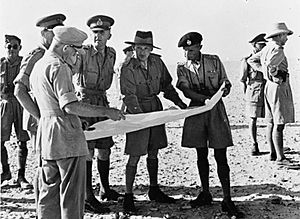
When Horrocks arrived in North Africa, his corps was ordered to defend the Alam el Halfa ridge in Egypt. This was against an attack by the Afrika Korps. Montgomery told Horrocks to stop Erwin Rommel's forces without losing too many soldiers. Horrocks prepared for a defensive battle. His tanks were dug in around the ridge. When the Germans attacked on 30 August, they couldn't trick the British tanks into moving. The Germans were hit hard by artillery and air attacks. The battle ended with the Germans holding one hill, but at a high cost. This success boosted morale. Horrocks was praised for inspiring confidence.
Horrocks was offered command of X Corps, an armored corps, for the big El Alamein offensive. He turned it down, believing another officer would be better. Instead, he kept command of XIII Corps. His job was to make a fake attack to the south to trick the Axis forces. The main attack would be in the north. Montgomery told him not to lose tanks.
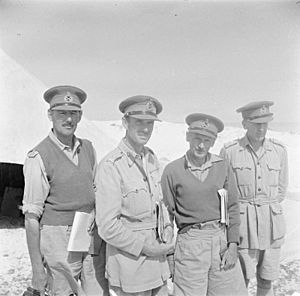
After the British victory at El Alamein, Horrocks's corps was put in reserve. It became smaller while the rest of the Eighth Army chased the retreating Axis forces. Horrocks said his corps became "the 8th Army's Mrs. Mopp," cleaning up the battlefield. In December, he took over command of X Corps. This was the leading corps in the Eighth Army's advance. He received the Distinguished Service Order for his service.
In March 1943, Horrocks led one of his most successful actions. His corps attacked as part of Operation Supercharge II. He led a flanking move through a pass the Germans thought was impossible to cross. This made the German position impossible to hold. Three Italian divisions were destroyed, and German divisions were badly weakened.
Horrocks continued to command X Corps. Then he was moved to the First Army to take over IX Corps. He led this corps in the final Allied attack in Tunisia in April and May 1943. They captured Tunis and accepted the surrender of Rommel's army. He was mentioned in official reports and received the Order of the Bath.
In June 1943, Horrocks was badly injured during an air raid in Bizerte. He had five operations and spent 14 months recovering.
Fighting in Northwest Europe
It took a year for Horrocks to recover. In August 1944, he was sent to France to command XXX Corps. This was during the battle of the Falaise Pocket, where many German forces were trapped. Montgomery was not happy with the corps's performance before Horrocks arrived. Horrocks led XXX Corps through Belgium, capturing Brussels. At one point, they advanced 250 miles in just six days.
Getting supplies was a big problem. The main French ports were still held by Germans. Montgomery's army was operating 300 miles from its supply points. So, XXX Corps was sent to Antwerp to capture its docks and harbor. The city and port were taken in early September. But Montgomery stopped XXX Corps before they could cross the wide Albert Canal north of the city. Horrocks later regretted this, believing they could have gone further. This pause allowed the Germans to regroup. The task of breaking the German line along the Scheldt River fell to the First Canadian Army.
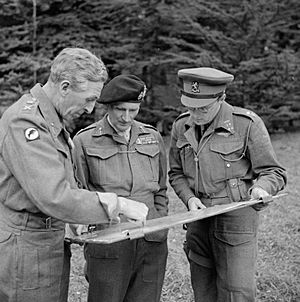
Operation Market Garden
In September, Montgomery planned a big attack across the Rhine into Germany, called Operation Market Garden. Horrocks's XXX Corps was to lead the ground attack. They were to link up with British airborne forces in Arnhem within four days. However, XXX Corps never arrived in time. The 1st Airborne Division fought for five more days, but most of them were destroyed or captured.
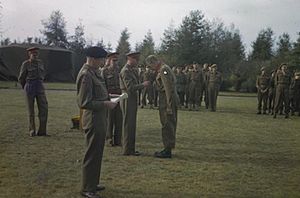
Some people later said Horrocks's men were too slow. Others pointed out that German defenses were much stronger than expected. Two SS Panzer divisions, which were very powerful, were in the Arnhem area. Intelligence reports had missed this. Counter-attacks by German forces also slowed the advance. The ground was difficult, forcing the tanks to use a single narrow road. The bridge at Nijmegen was not captured as planned, causing a 36-hour delay.
Horrocks was not personally blamed for the failure. He wrote in his book, "If we were slow then the fault was mine because I was the commander." He added that his troops fought very well. He believed that even if they had reached Arnhem, it would have been hard to hold the area. He felt they were "lucky" in the long run.
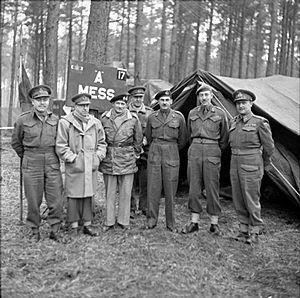
During this operation, the U.S. 82nd Airborne Division was under Horrocks's command. Its commander, Brigadier General James M. Gavin, was very impressed by Horrocks. He called him "the finest general officer I met during the war."
After the failed operation, XXX Corps captured its first German town, Geilenkirchen. During the Battle of the Bulge, Montgomery briefly sent Horrocks back to Britain to rest. He felt Horrocks had become "nervy."
In early 1945, XXX Corps took part in Operation Veritable. They pushed the German Army back over the Rhine. Before the operation, Horrocks agreed to use air attacks on the town of Cleves to help the advance. The operation was successful. By February 9, XXX Corps had broken through the German defenses with few losses.
XXX Corps began crossing the Rhine on 23 March. There was strong resistance, especially at Lingen. But after that, they moved quickly. They captured Bremen on 26 April, taking 6,000 prisoners. This also led to the discovery of the Sandbostel concentration camp. XXX Corps reached Cuxhaven when the war ended in May.
Horrocks received more honors for his service. He was made a Knight Commander of the Order of the British Empire. He also received awards from the governments of Belgium, France, the Netherlands, Greece, and the United States.
On 12 April 1945, Horrocks met with German officers to arrange a ceasefire around the Bergen-Belsen concentration camp. When the camp was freed on 15 April, Horrocks quickly organized food, water, and medical help for the thousands of prisoners.
After the War: A Full Life
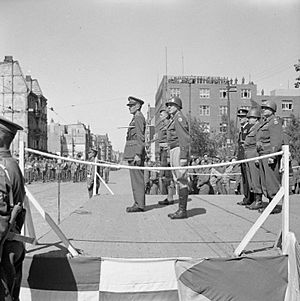
After the war, Horrocks continued to serve in the army. He was promoted to full lieutenant-general in 1946. He briefly commanded the British Army of the Rhine. But he became ill in August 1948 because of his old war wounds. He had to retire early from the army in January 1949.
In 1949, he was appointed Gentleman Usher of the Black Rod. This is a traditional role for retired officers in the House of Lords. Black Rod manages the House of Lords and takes part in ceremonies. In 1957, he famously had to ask actress Vivien Leigh to leave the House when she interrupted a meeting. Horrocks held this job until 1963.
Horrocks also became a writer. He wrote articles for newspapers and magazines. This led to a successful career as a television presenter. He hosted shows like British Castles and Men in Battle. He talked about famous historical battles, making them exciting for a wide audience. He was also interviewed for the TV series The World at War.
After his TV career, Horrocks worked for a housebuilding company. He continued to write, including a column for The Sunday Times. He also edited a series of British Army history books.
In 1968, Horrocks helped create a board game called Combat. His picture and signature were on the box. He wrote that in war, "no two battles are ever the same."
His autobiography, A Full Life, was published in 1960. He also co-wrote Corps Commander in 1977.
Horrocks was a military consultant for the 1977 film A Bridge Too Far, which was about Operation Market Garden. He was also a character in the film, played by Edward Fox. Fox said he enjoyed playing Horrocks because they became friends.
Brian Horrocks died on 4 January 1985, at the age of 89. A memorial service was held for him at Westminster Abbey. He had asked for a simple ceremony with no hymns or flowers. His remains were cremated. In 2022, his ashes were buried at St Paul’s Church in Mill Hill.
See also
 In Spanish: Brian Horrocks para niños
In Spanish: Brian Horrocks para niños


